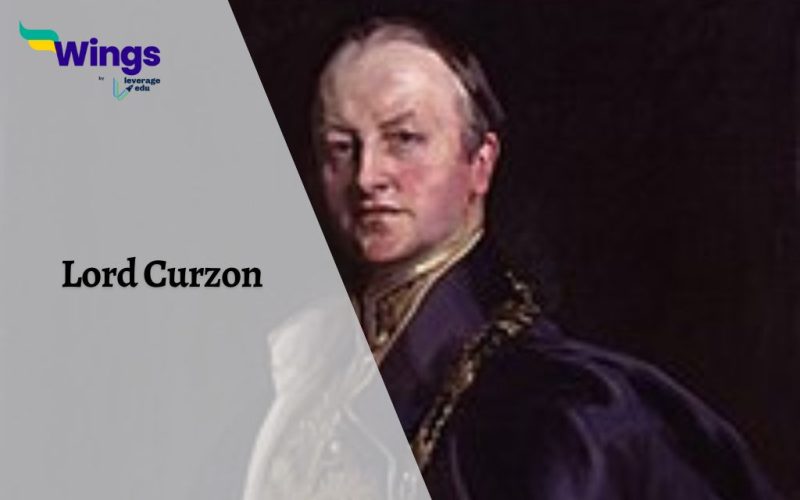Lord Curzon, also widely known as Baron Curzon of Kedleston or Earl Curzon of Kedleston, was the viceroy of India from 1895 to 1905. This British statesman is well remembered in Indian history for dividing the region of Bengal into two provinces. In this blog, we will explore the early life of Lord Curzon, his time in India as the viceroy, and the partition of Bengal in detail.
Table of Contents [show]
Early Life of Lord Curzon
- Lord Curzon was the first son of the 4th Baron Scarsdale.
- It is believed that the neglect of his parents and a strict governess significantly influenced his early life.
- He completed his early education at Eton where he also developed a passion for debates and the assimilation technique.
- Curzon entered Oxford in the year 1878 where he was elected as the president of the Oxford Union in 1880.
- He also served as Under-Secretary of State of India (1891 – 1892) and Foreign Affairs (1895 – 1898) before being finally appointed as the Viceroy.
His Political Rise
Being related to an esteemed position, Lord Curzon had gradually developed a taste for lavish and luxurious life. However, all his financial woes went away upon his marriage to Mary Victoria Leiterm a millionaire. The grand wedding took place on April 22, 1895, in Washington, DC. When the newly married couple returned from their honeymoon, Lord Salisbury presented the groom with an esteemed opportunity to become undersecretary of state.
By accepting Salisbury’s invitation, he entered the world of politics on November 10, 1891. His only condition was to also be made a privy councilor. He was sworn in by Queen Victoria on June 29, 1895.
Viceroy of India
It is known only to a few that Lord Curzon was the youngest viceroy of India in history. He realized the powers that had just been bestowed and cherished every bit of his reign. Moreover, he was unlike other rulers. For instance, Lord Curzon demanded a bent knee from Indian rulers and provincial governors. Despite his rigid rules for obedience, Lord Curzon also initiated commissions of inquiry in various sectors including education, civil services, and police.
Apart from this, Lord Curzon is also remembered for reducing taxes. To support the poor and oppressed sections of the society, he demanded immediate punishment of British officials who ill-treated Indian nationals.
The Partition of Bengal- Motives
- The rising tides of nationalism were evident in the Indian subcontinent. By dividing Bengal into two provinces, Lord Curzon wanted to suppress the feeling of nationalism in citizens.
- He realized that the lifespan of British rule in India could be increased by securing an alliance with Muslims living in India.
- Lord Curzon aimed to hinder the prosperity and solidarity of Indian society by using the minority section of the society against the majority population.
- Sir Syed Ahmad Khan’s famous book, the Indian Musalman, further changed the attitude of the British towards Muslims.
- The western part of Bengal was a Hindu majority whereas eastern Bengal was a Muslim majority. This further fueled the desire of British authorities to divide Bengal.
- The British forces used the excuse that Muslims had been fighting for their homeland since the days of Prophet Muhammad. Therefore, the British forces would do the right thing by fulfilling their wish.
Also Read: Bengal Partition: A Tale of Division between Hearts and Lands
Acts Introduced by Lord Curzon
Below we have mentioned a few noteworthy acts introduced by Lord Curzon during his reign in India.
Calcutta Corporation Act
- The Calcutta Corporation Act was introduced in the year 1899.
- It was aimed against the growing desire for self-governance among Indian citizens.
- This act reduced the number of elected legislatures and increased the number of nominated legislatures.
- In this way, the act deprived Indian citizens of their few chances of getting into the legislature.
- In opposition to this act, around 28 members of the Calcutta Cooperation resigned from their posts.
Ancient Monuments Preservation Act
- The Ancient Monument Act was released in 1904.
- It established the famous Archaeological Department with the primary aim of repairing, protecting, and restoring the historical monuments of the country.
- Lord Curzon also met with provincial governments and urged to set up museums to protect antique objects.
Punjab Land Alienation Act
- Lord Curzon introduced the Punjab Land Alienation Act in 1900.
- It disallowed the transfer of funds from the peasants to the moneylenders if the peasants were unable to pay off their debts.
Co-Operative Credit Societies Act, 1904
- The Co-Operative Credit Societies Act was introduced by Lord Curzon in 1904.
- It enabled citizens to constitute societies for deposits and loans.
- This act also safeguarded poor peasants from approaching the money lenders in need of money.
Educational Reforms
- Lord Curzon organized an education conference in Shimla in the year 1901. According to its findings, the University Commission was appointed in the following year.
- This Commission enacted the Indian Universities Act in 1904.
- The primary objective of this Act was to increase the overall control and management roles of the colonial government over the Indian universities.
Railways
- Lord Curzon appointed a Railway Commission in 1901.
- He wanted to expand and improve the railway facilities in India. For this, the commission submitted its report which was accepted by Lord Curzon.
- Accordingly, the railway lines were expanded.
- The report also removed the Railway Department.
- The administration powers were transferred to the newly established Railway Board. It consisted of three members.
This was all about Lord Curzon. If you wish to read more such informative blogs, check out our general knowledge page.
 One app for all your study abroad needs
One app for all your study abroad needs















 45,000+ students trusted us with their dreams. Take the first step today!
45,000+ students trusted us with their dreams. Take the first step today!
